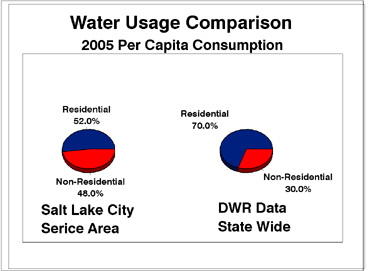Non-Resident Population Distorts Salt Lake City’s Per Capita Water Consumption Results
LeRoy W. Hooton, Jr.
September 27, 2007
Salt Lake City is disproportionately impacted by non-resident daytime population, including commercial, institutional, seats of government and visitor populations. According to the Census Bureau, Salt Lake City ranks 3rd highest for commuter-to-residents of cities of its size or larger nationwide (Deseret News, April 25, 2006), with 131,180 workers added to the City’s 181,743 resident population every work day. Some examples of the City’s non-residential water consumption establishments are the University of Utah, Research Park, downtown hotels and businesses and the City’s third largest water user an oil refinery. Much of the City’s Northwest Quadrant is currently non-residents with the International Airport and International Center hosting tens of thousands of visitors and workers daily.
|
The current calculation method, in some cases, creates inequity between residents of different communities based on the level of non-resident water consumption occurring in a particular community. It is recognized that it is impossible to take into account all of the factors that affect per capita consumption without adding a level of unacceptable complexity; however, where legitimate and documented non-resident water uses drastically distort a community’s per capita consumption calculation, there needs to be an acceptable process to more accurately measure and report the per capita consumption of that community.
